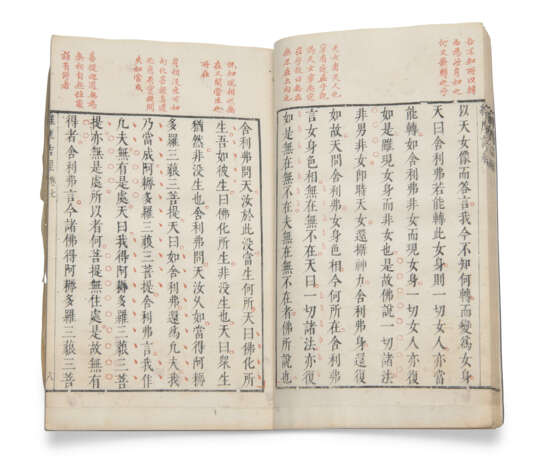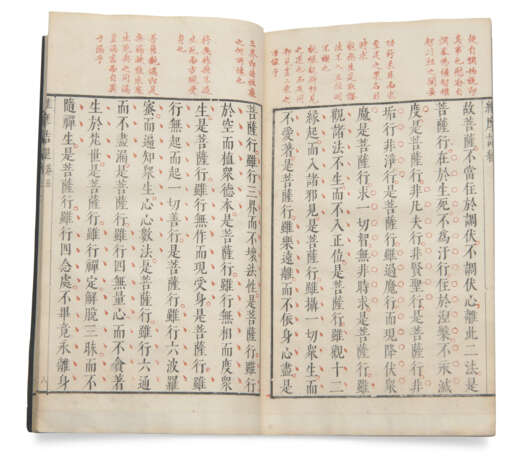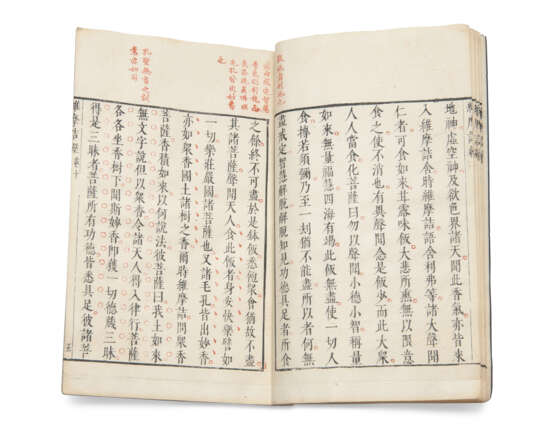ID 1053269
Lot 155 | Chinese Gongche Notation
Valeur estimée
£ 3 000 – 5 000
Weimojie suo shuo jing (維摩詰所說經), a translation of the Vimalakīrti Nirdeśa; and Ling Mengchu, 'A praise to Vimalakirti', in Chinese, blockprint and manuscript on paper [China, 17th century]
A remarkable copy of Kumārajīva's Chinese translation of the Buddhist sutra Vimalakīrti Nirdeśa, with traditional Chinese Gongche notation, produced during the late Ming or early Qing dynasty.
c. 277 x 170mm. 4 volumes, complete, up to 17 columns, 18+3 characters in Chinese book script, additions in red on top of every page, Gongche notation in red; the manuscript in 10 columns, 26 characters in Chinese script; 1 full-page frontispiece depicting an arhat, or perhaps a portrait Sakyamuni (see below) seated next to his bag under a pine tree, painted by Wang Wenhen (a few wormholes). 18th-century binding stitched on 4 stations (xiang zhuang), dark blue paper covers.
Provenance:
(1) Ekky Chung collection, Indonesia and Beverly Hills, California.
(2) Sam Fogg, London, acquired in 1998 by:
(3) Schøyen Collection, MS 2601.
Text and music:
Tradition holds that the text of the Vimalakīrti Nirdeśa was translated into Classical Chinese seven times. Three canonical Chinese versions are extant: an earlier version ascribed to Zhi Qian 支謙, entitled Weimojie jing; one produced by Kumārajīva 鳩摩羅什 in 406 C.E. under the title Weimojie suoshuo jing; and one translated by Xuanzang in 650 玄奘 and is entitled Shuo Wogoucheng jing. Of these, the Kumārajīva version is the most famous, and is the one extant in the present manuscript. The sutra is an apocryphal account of conversations between Sakyamuni and some residents of Vaisali, and a debate between Manjusri and Vimalakirti, telling the story of Vimalakirti, a well-known lay Buddhist philosopher, who was unwell one day. Sakyamuni requested one of his disciples to comfort this wise man. Everyone declined because in the past they had all been reproached by him for their faults, and the thought of facing him again filled them with dread. Eventually, this task was bestowed upon Manjusri, who was the most eloquent and erudite Bodhisattva. The contents of these conversations are both philosophical and highly regarded for their literary content and created a rich and enlightened lay Buddhist image that had boosted the popularity of the Mahayana Buddhism among the upper class in China.
The 1998 description from Sam Fogg suggested that the frontispiece depicted Bodhirharma, a famous Chan master from India. The same frontispiece, by Wang Wenhen, precedes another 17th-century copy of the Weimojie suo shuo jing at the Library of Congress, Chinese Rare Book Collection, item 2012402524, where it is identified as a portrait of Sakyamuni.
The praise to Vimalakirti by the famous novelist of the Ming Dynasty Ling Mengchu (1580-1644), best known for his vernacular short fiction collections Slapping the Table in Amazement (拍案驚奇), is hand-written in a beautiful semi-cursive style, block-printed before the main text.
Gongche notation or gongchepu is a traditional musical notation method, once popular in ancient China. It uses Chinese characters to represent musical notes. It was named after two of the Chinese characters that were used to represent musical notes, namely "工" gōng and "尺" chě.
| Lieu d'origine: | Chine |
|---|---|
| Catégorie maison de vente aux enchères: | Manuscrits médiévaux et de la Renaissance |
| Lieu d'origine: | Chine |
|---|---|
| Catégorie maison de vente aux enchères: | Manuscrits médiévaux et de la Renaissance |
| Adresse de l'enchère |
CHRISTIE'S 8 King Street, St. James's SW1Y 6QT London Royaume-Uni | ||||||
|---|---|---|---|---|---|---|---|
| Aperçu |
| ||||||
| Téléphone | +44 (0)20 7839 9060 | ||||||
| Commission | see on Website | ||||||
| Conditions d'utilisation | Conditions d'utilisation |







